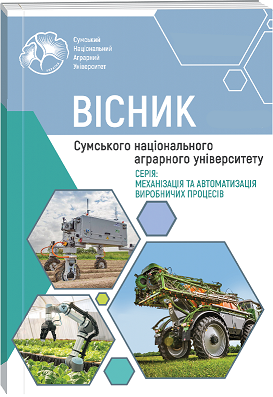INVESTIGATION OF THE INFLUENCE OF DISCUSSION CONDITIONS ON THE QUALITY INDICATOR
Abstract
The intense processes of climate change and the growing pace of population change on earth require new approaches to efficiency in agricultural production. Every hectare must be used as efficiently as possible. It is the mechanization of the cultivation of agricultural crops that hides the hidden potential of the efficiency of agricultural production in the field of crop production. One of the urgent problems of the industry is ensuring the quality of mechanized technological operations. The productivity of agricultural crops in modern conditions depends on 25–30% of the available means of mechanization. The conducted studies established that the works devoted to the efficiency of mechanized technological operations do not contain data and do not provide for the possibility of determining and analyzing the impact of the quality of field work performed by machine units on productivity. The analysis of literary sources, the experience of agricultural enterprises, and our own observations give grounds for concluding that the working modes and parameters of the use of machine aggregates have an impact on the yield of crops. It is the quantitative and qualitative composition of the complex of machines that forms the yield indicator in terms of the mechanization of operations due to the degree of provision of agricultural requirements. During field studies of the effectiveness of the use of machine units in different operating modes and with different control parameters, a different degree of ensuring the quality indicator was established (the creation of conditions by the machine unit in accordance with the needs of the plants). In real production conditions, the influence of such indicators as working speed, uniformity of tillage depth, working furrow length, and soil hardness has been established. Research was conducted in various farms of the Sumy region and on various units for 5 years. The research was carried out jointly with the Loziv Forging and Mechanical Plant, the companies Elvorti and ATS Ukraine (Horsch) on the territory of Ukraine. Quality indicators during tillage with disc tools were investigated. The obtained empirical dependencies make it possible to increase the adequacy of the technique of obtaining technical and operational indicators.
References
2. Bondar S. M., Melnyk I. I. (2000). Osnovni problemy mashynovykorystannia v suchasnykh tekhnolohiiakh obrobitku gruntu Polissia Ukrainy [The main problems of machine use in modern technologies of soil cultivation in the Polish region of Ukraine]. Naukovyi visnyk NAU. Vyp. 33. S.101-107 (in Ukrainian).
3. Melnyk I. I., Marchenko V. V., Mykhailovych Ya. M. (2001). Optymizatsiia kompleksiv mashyn i struktury mashynnoho parku ta planuvannia tekhnichnoho servisu [Optimization of machine complexes and the structure of the machine park and planning of technical service]. Kyiv: NAU. 120 s. (in Ukrainian).
4. Hrechkosii V. D., Dmytryshak M. Ya., Shatrov R. V., Mokriienko V. A. (2013). Kompleksna mekhanizatsiia buriakivnytstva [Complex mechanization of beet growing]. Vinnytsia: Nilan. 357 s. (in Ukrainian).
5. Pastukhov V. I. (2006). Obgruntuvannia optymalnykh kompleksiv mashynnykh ahrehativ dlia mekhanizatsii polovykh robit [Justification of optimal complexes of machine units for the mechanization of field work.]. Dysertatsiia na zdobuttia naukovoho stupenia doktora tekhnichnykh nauk po spetsialnosti 05.05.11 – mashyny i zasoby mekhanizatsii silskohospodarskoho vyrobnytstva. Kharkiv. 419 s. (in Ukrainian).
6. Flehantov L. O., Ovsiienko Yu. I. (2019). Optymizatsiia kilkisnoho skladu zbyralno-transportnoho kompleksu silskohospodarskykh mashyn zasobamy Excel [Optimizing the quantitative composition of the collection and transport complex of agricultural machines using Excel.]. Kharkivskyi Natsionalnyi tekhnichnyi universytet silskoho hospodarstva. Vyp. № 199. S. 366-379. (in Ukrainian).
7. Kovtun Yu. I., Mazorenko, D. I., Pastukhov, V. I. (2000). Ahrokvalimetriia [Agroqualimetry]. Kharkiv: RVP Oryhinal. 312 s. (in Ukrainian).
8. Melnyk I. I., Tyvonenko I. H., Fryshev S. H. (2007). Inzhenernyi menedzhment. Navchalnyi posibnyk [Engineering management. Tutorial]. Vinnytsia: Nova knyha. 536 s. (in Ukrainian).
9. Melnyk I.I., Zubko V.M., Khvorost T.V. (2015). Informatsiina tekhnolohiia otsinky roboty mashynnykh ahrehativ [Information technology for evaluating the operation of machine units.]. Visnyk Kharkivskoho natsionalnoho tekhnichnoho universytetu silskoho hospodarstva imeni Petra Vasylenka. - Vyp. 156. - S. 222-230. (in Ukrainian).
10. Biletskyi Ye. M., Bobro M. A., Bulyhin S. Yu. (2010). Suputnyk ahronoma: (dovidnyk) [Agronomist's companion: (handbook)]. Kharkov: KhNAU. 256 s. (in Ukrainian).
11. Saiko V. F., Maliienko A. M., Kolomiiets M. V. (1987). Dovidnyk po vyznachenniu yakosti polovykh robit [Guide to determining the quality of field work]. Kyiv: Urozhai. 120 s. (in Ukrainian).
12. Melnyk I.I., Zubko V.M. (2009). Metodyka prohnozuvannia vtrat vrozhaiu ozymoho ripaku z urakhuvanniam mozhlyvostei zabezpechennia ahrovymoh vykonannia operatsii mashynnymy ahrehatamyiu [The method of forecasting winter rapeseed crop losses, taking into account the possibilities of meeting the agricultural requirements of performing operations with machine units]. Naukovyi visnyk Natsionalnoho universytetu bioresursiv i pryrodokorystuvannia Ukrainy. – Kyiv: NUBiP. 2 Vyp. 134, ch.2. – S. 37-41. (in Ukrainian).

 ISSN
ISSN  ISSN
ISSN 



